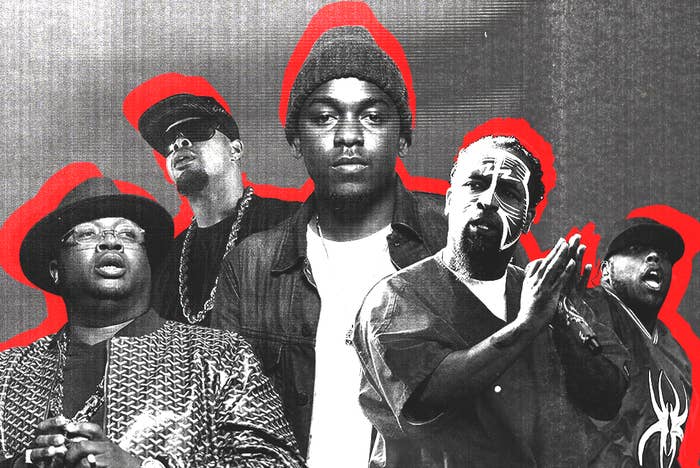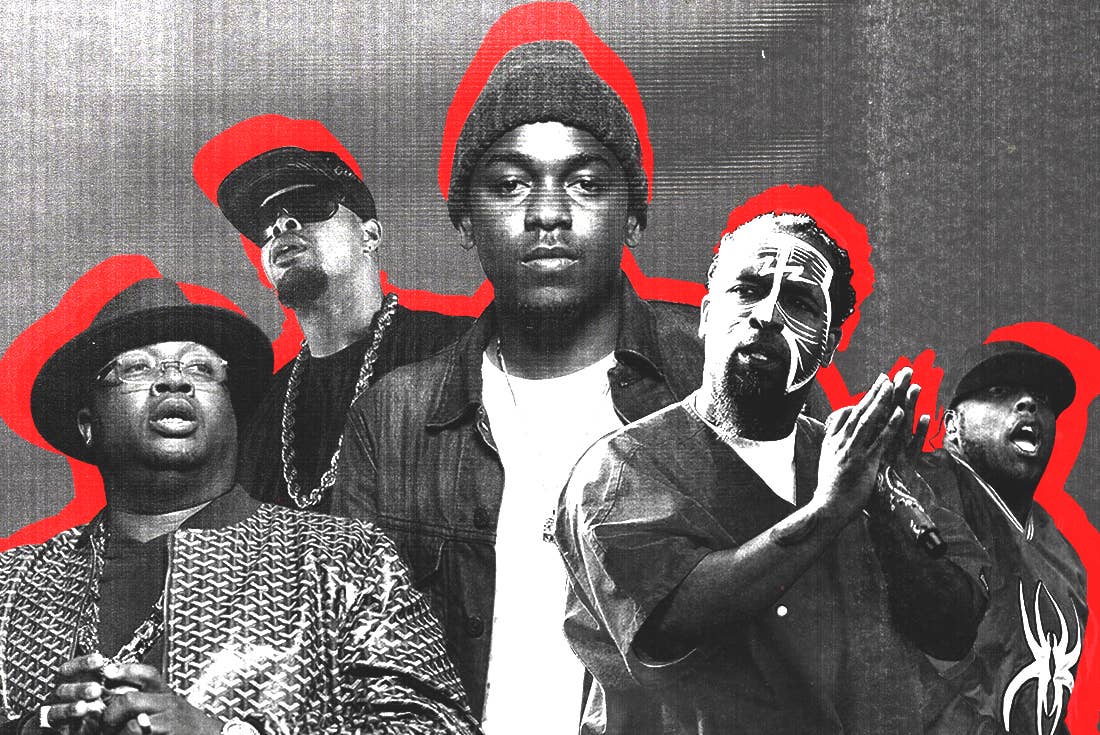
On August 16, 2017, Kendrick Lamar was on top of the world. His album Damn, just a few months away from winning him a Pulitzer Prize, had recently been certified double platinum, and he was in the midst of a tour that would gross him over $40 million. But Kendrick had something else on his mind.
In the middle of a show at Kansas City’s Sprint Center, Lamar took a few minutes between songs to thank some very special audience members.
“Certain artists gave me and my boy an opportunity to learn what it’s like to be professional onstage,” he began. “What it’s like to turn your true lyricism out the booth and bring it on here and give it all you got on this motherfuckin’ stage. Real shit.”
The crowd cheered, sensing what was coming next.
“And them artists,” Kendrick continued, “go by the name of motherfuckin’ Tech N9ne and Krizz motherfuckin’ Kaliko, man, I swear to God.”
“It was almost a decade ago,” he remembered. “That was my first experience on tour, and I was soaking up so much game. A humble student before I even knew what humble was.”
Kendrick paused for a second, as a funny memory popped into his head. “Better yet, that was my first time hearing about motherfuckin’ per diem.” Temporary bemusement over, he finished, “I want to give a salute to Tech N9ne, Krizz Kaliko, and the whole Strange Music family for being true big brothers when we was just scrubs in this shit.”
The monologue made local headlines, and of course onto Tech and Kaliko’s social media, but otherwise it passed unnoticed as just another speech in another city midway through a long tour. But it provides a look into a key part of Kendrick’s development as an artist, and gives us some clues as to how Top Dawg Entertainment became the music juggernaut they are today.
In March 2009, Todd Moscowitz landed a new job. The longtime record executive moved to Warner Bros. Records, bringing along Asylum Records (where he had been president) to the family of labels.
Richie Abbott, who was running urban publicity for Warner at the time, remembers the move very well. He says Moscowitz realized Southern rappers, like the ones he was working with at Asylum, were running things, and prioritized accordingly.
“After Todd took over, his agenda changed and essentially he put all the money in the budgets into his artists” like Gucci Mane and OJ da Juiceman, Abbott remembers. That left one Warner signee who out in the cold.
“What I remember about [Kendrick] is the way he dressed. It was weird. It was like cut-off jean shorts that were frayed, and knit hooded shirts like a hippie. Something like Crocs on his feet, and he’d wear a hat.” - Tech N9ne
Jay Rock had spent the previous few years at Warner, with no album release to show for it. The Watts-repping rapper spent “every day,” Abbott recalls, at Warner’s Cali headquarters, and the L.A.-based Abbott got along with Rock and his whole team, hanging with them frequently starting in 2007.
Part of the circa-2007 team was a guy Abbott recalls as a “quiet little dude kicking it in the corner, saying nothing”: Kendrick Lamar, then rapping as “K-Dot.”
“The only time I'd hear him is when he'd pop up on these mixtapes that Jay Rock was putting out with DJ Skee or whoever,” Abbott remembers. “All of a sudden K-Dot is featured on like four of these tracks.”
But a few years in, young Kendrick stepped up his game.
“I think it was [TDE president] Punch [who] passed me a record that K-Dot had just done, and it was called ‘Bitch I'm In The Club,’” Abbott says. “I was like, ‘Is that you, K-Dot?’ He was like, yeah. He kept smiling and smiling. That's when I started to become a fan of his, right there. And then things started to go south not long after that.”
Once Moscowitz took over, Jay Rock and the rest of TDE could tell that their days at Warner were numbered. Even getting Lil Wayne on a track wasn’t enough. But the final straw came when Jay Rock was included in XXL’s 2010 Freshman Class and, Abbott says, the label wouldn’t pay for the rapper to get to New York City for the cover shoot. “That's when I knew that it was just a matter of time before TDE would depart,” he says.
In 2010, Abbott connected TDE with his friends at Strange Music, a Kansas City-based independent label that he had been working with as a side job since 2004. The label’s co-founder and flagship artist is Tech N9ne.
“He was stuck on Warner Bros,” Tech remembers of Jay Rock, on the phone from Bulgaria. “Richie was like ‘They got Jay Rock over there, just sitting on Warner. We really need to do something for him.’ And we did.”
That was the beginning of Jay Rock’s affiliation with Strange, a label better known for rock-influenced, fast-rapping Midwest choppers than West Coast gangster spitters. The pairing was unlikely, but it helped TDE (Kendrick especially) move to the next phase of their careers.
Even before putting out his long-delayed album, which would drop the following year, it was clear that the logical first move would be to get Jay Rock on tour in front of Strange’s rabid fanbase. So, in the fall of 2010, Jay Rock joined the Independent Grind Tour along with Tech and his longtime onstage foil Krizz Kaliko, as well as E-40, Glasses Malone, Kutt Calhoun, and Big Scoob.
Jay Rock needed a hype man. He was in search of someone to keep the crowd going during his set, and perhaps to sneak in a song or two of his own, as well. So Lamar, who had just completed Overly Dedicated and was by this time rapping under his real name, fell into the role.
The tour, per usual with Strange Music, was a grueling affair: 43 shows in 45 days. That style of touring, still in place almost a decade later, reflects the hard-working personalities of Tech and his Strange co-founder Travis O’Guin.
“It's a machine, and I think that comes from Tech and Travis,” explains Jeff Nelson, who was Strange’s senior blog editor at the time. “Those two, not to rob them of humanity, but they're very machine-like people. So the tours, when they're designed by someone like Travis and designed for someone like Tech, there really wasn't a lot of time to fuck around.”
“Just being on stage is not enough. You have to have this certain it factor, and I think that he learned that from us.” - Krizz Kaliko
In addition to a level of precision demanded out of the performers and crew that recalled the famously tight James Brown bands of the 1960s, there were also James Brown-style fines. If there was a girl on the bus and it left the city: fine. Weed on the bus: fine.
“Even people who have toured before learn how to tour when they tour with us, because of how hard our tours are,” says Krizz Kaliko, who, like Tech, is overseas on tour when I reach him on the phone, heading from Paris to Vienna. “They're very regimented. It's almost military how we function. Our whole staff is in uniform, we're never late to shows. We give 110 percent every single night.”
Kendrick, meanwhile, was the opposite, at least sartorially. Tech chuckles when he thinks about it now. “What I remember about him is the way he dressed,” he says. “It was weird. It was like cut-off jean shorts that were frayed, and knit hooded shirts like a hippie. Something like Crocs on his feet, and he’d wear a hat.”
New to the road and with one short set per concert, there was a lot for Kendrick to learn. He would watch Tech and Krizz “every night,” Kaliko says, picking up performance tips along the way. Kendrick spent most of his time onstage telling crowds to “put your motherfuckin’ hands up,” but he would usually get one solo song a night, often the Kendrick Lamar EP cut “I Do This.”
Kaliko, Tech’s hype man and a solo artist himself, initially didn’t give the young Kendrick, who was in a similar situation, a chance. “I suffer from the same thing, being somebody's hype man like I've been for years: people don't know what caliber of an artist I am,” Kaliko admits. “And I did the same thing to him. I was like, well, he's a hype man. I wasn't really paying attention to him. But then I saw him perform one night, and Jay Rock was letting him do a song. I went back and listened to the CD he gave me and I was like, damn, dude is dope.”
“I'm happier for him than he is probably happy for himself.” - E-40
When Kendrick wasn’t onstage (or doing meet-and-greets), he was finding other ways to be on the mic. After the tour arrived in a city, E-40 would usually retire to a hotel and set up a portable studio. Sometimes his fellow Californians would join him. (“We got songs that nobody heard,” he says of himself, Kendrick, and Jay Rock.)
Everything involved with the tour—seeing the efficient Strange Music touring operation, watching experienced performers every night, winning over crowds who didn’t know K-Dot from dipping dots, experiencing meet-and-greets, seeing the label’s business up-close, constantly recording during down time—was being studied by Kendrick and the whole TDE crew. Kaliko says Lamar’s song structures even changed because of what he experienced on Independent Grind.
“[Kendrick] learned to write music to actually perform,” Kaliko explains. “You have to be able to write songs that people can sing along with. And if you notice, his choruses are stuff that you can sing with. I think he learned how to perform and how to have that stage presence. Just being on stage is not enough. You have to have this certain it factor, and I think that he learned that from us.”
E-40, too, saw that Kendrick was intent on educating himself. “[He was] watching them performances, looking at the stage props,” 40 remembers. “Just keeping his ear to the soil. Watching everything, being an observer, being a spectator, a student.”
When he blew up, all the fans were like, ‘I did not know that I met Kendrick Lamar at that meet and greet. - Tech N9ne
While Lamar was getting his professional bearings, what about the people around him? Did people on or around the tour have any idea that they were in the presence of a future hip-hop icon?
“Could I predict that he was going to be a superstar? Hell no, nobody could. If anybody says that, they're lying,” admits Abbott. “Unless it was somebody from his own immediate camp who really believed in him. But the Kendrick you saw in 2009, 2010, you wouldn't say, ‘That guy is going to win a Pulitzer Prize someday.’ This kid reinvented himself and separated himself from the pack.”
A review of the tour’s Eugene, Oregon stop has a small mention of Kendrick, saying he and Jay Rock “thoroughly pleased” the audience with “I Do This.” Tech agrees, remembering that “people loved” Kendrick’s brief moment in the spotlight that tour, “even though they didn’t know who he was. When he blew up, all the fans were like, ‘I did not know that I met Kendrick Lamar at that meet and greet.’” Tech laughs at the memory.
Despite everything that has changed for Kendrick Lamar between 2010 and today, what is most surprising, at least on the outside, is how much has remained the same. Talking to people involved with the 2010 tour brings repeated recollections of how little the rapper himself has let stardom go to his head.
“I met him two times: once on that tour as Jay Rock's hype man, and then once at the opening act on the Yeezus Tour,” Nelson says. “I'm telling you: he was the exact same both times, and I wouldn't be surprised if he's the same guy now.”
Everyone is ecstatic that the artist Krizz Kaliko remembers as “this little quiet, very humble kid” has blown up.
“I'm happier for him than he is probably happy for himself,” says E-40. “Everybody on that tour, we was all just one big family. We respect and got nothing but love for each other.”





